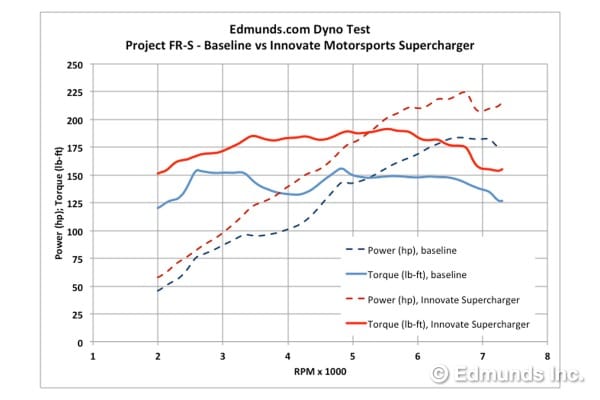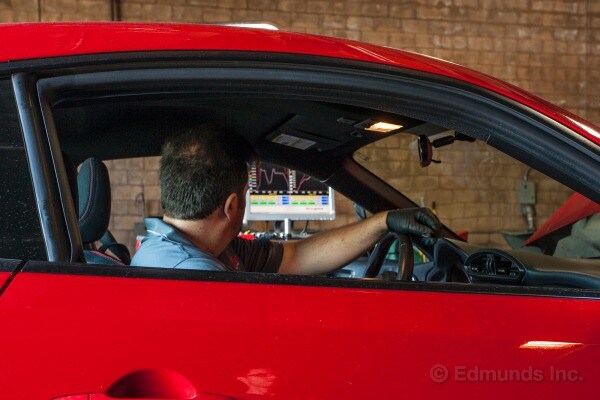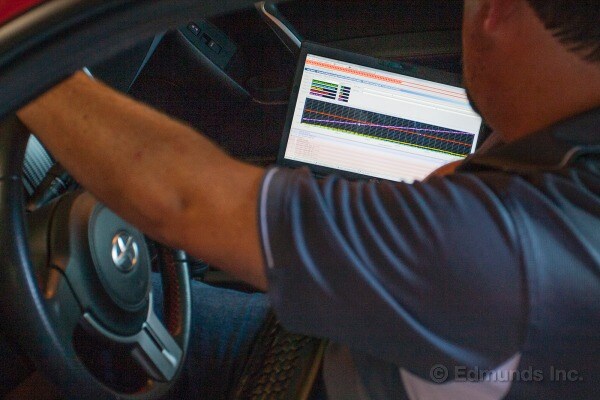Submitted by William Knose on
Everyone wants "apples to apples" or at least they should. It's the only way to go. The day before the Innovate Motorsports supercharger kit was installed on Project FR-S, our long-term 2013 Scion FR-S, I visited Church Automotive Testing in Wilmington, California. The boss man there, Shawn Church, performed several pulls and established a baseline on our car, stock save for its Apexi catback exhaust. Immediately after the supercharger kit was installed the next day, I again rolled straight to Church Automotive Testing. Several pulls were performed and the car's stabilized, supercharged output obtained. Same car, same dyno, same dyno operator, same methodology, same weather, even the same 91 octane fuel in the tank. Identical apples all around. Here's what we found.  Above, the blue traces show Project FR-S in baseline, pre-supercharger form made (as measured at the hubs) a max of 155 lb-ft at 4,800 rpm, while power peaked at 184 horsepower at 6,650 rpm. Even if no units or legend were present in the graph, you'd be able to tell this was a basically stock Scion FR-S due to its torque crater between 3,300 and 4,700 rpm. As soon as you put your foot down the Innovate Motorsports supercharger is generating boost. Below 2,700 rpm it's around 3.5 psi, rising to 5 psi at 4,000 rpm. After that it rises to a max of about 8.5 psi at 6,300 rpm. As such, the supercharged torque curve is higher than our baseline at every point in the rev range. In red above, the Innovate Motorsports supercharger kit kicks things up to peaks of 191 lb-ft at 5,550 rpm and 224 horsepower at 6,700 rpm. Now that's more like it. Peak numbers only tell part of the story, as the supercharger has significantly increased the area under the curve. Take a look at the torque crater. Gone. The blower fills it right up and then some. In fact, that's where the Innovate Motorsports supercharger kit sees its largest gains. At 4,200 rpm, the supercharger kicks out 52 lb-ft more torque than our baseline. Doing the same exercise for power shows that at 5,850 rpm the blower generates its max delta of 45 horsepower over the baseline.
Above, the blue traces show Project FR-S in baseline, pre-supercharger form made (as measured at the hubs) a max of 155 lb-ft at 4,800 rpm, while power peaked at 184 horsepower at 6,650 rpm. Even if no units or legend were present in the graph, you'd be able to tell this was a basically stock Scion FR-S due to its torque crater between 3,300 and 4,700 rpm. As soon as you put your foot down the Innovate Motorsports supercharger is generating boost. Below 2,700 rpm it's around 3.5 psi, rising to 5 psi at 4,000 rpm. After that it rises to a max of about 8.5 psi at 6,300 rpm. As such, the supercharged torque curve is higher than our baseline at every point in the rev range. In red above, the Innovate Motorsports supercharger kit kicks things up to peaks of 191 lb-ft at 5,550 rpm and 224 horsepower at 6,700 rpm. Now that's more like it. Peak numbers only tell part of the story, as the supercharger has significantly increased the area under the curve. Take a look at the torque crater. Gone. The blower fills it right up and then some. In fact, that's where the Innovate Motorsports supercharger kit sees its largest gains. At 4,200 rpm, the supercharger kicks out 52 lb-ft more torque than our baseline. Doing the same exercise for power shows that at 5,850 rpm the blower generates its max delta of 45 horsepower over the baseline.  Over the course of a number of dyno pulls at Church Automotive Testing, the kit produced very consistent results. Innovate Motorsports developed their calibration on 91 octane California fuel, which is a worst case scenario as premium fuel goes. This is good news for anyone considering this kit because this means that the deltas we measured are probably the minimum you can expect. For example, if you were to fill with the 93 octane premium available in other regions, the dip in power at 6,900 we observed (due to learned ignition retard) would likely fill in, bumping up the peak power number. Innovate reports that that retard is something that's observed only on long dyno pulls from low revs (such as our 2,000 rpm starting point) and that the map timing is unaltered in street driving. Ah, octane. Such an elusive creature in California.
Over the course of a number of dyno pulls at Church Automotive Testing, the kit produced very consistent results. Innovate Motorsports developed their calibration on 91 octane California fuel, which is a worst case scenario as premium fuel goes. This is good news for anyone considering this kit because this means that the deltas we measured are probably the minimum you can expect. For example, if you were to fill with the 93 octane premium available in other regions, the dip in power at 6,900 we observed (due to learned ignition retard) would likely fill in, bumping up the peak power number. Innovate reports that that retard is something that's observed only on long dyno pulls from low revs (such as our 2,000 rpm starting point) and that the map timing is unaltered in street driving. Ah, octane. Such an elusive creature in California.  It's worth mentioning that our results were obtained on a Dynapack dyno, so our results are not directly comparable to your buddy's numbers from a Dynojet, or any other kind of dynamometer. The absolute numbers will vary from dyno to dyno for a number of reasons. The real meats of the situation are the differences between before and after. Jason Kavanagh, Engineering Editor Footnote: Jason Kavanagh, Edmunds.com, http://www.edmunds.com/scion/fr-s/2013/long-term-road-test/2013-scion-fr-s-innovate-motorsports-supercharger-kit-dyno-tested.html (July 24 2013).
It's worth mentioning that our results were obtained on a Dynapack dyno, so our results are not directly comparable to your buddy's numbers from a Dynojet, or any other kind of dynamometer. The absolute numbers will vary from dyno to dyno for a number of reasons. The real meats of the situation are the differences between before and after. Jason Kavanagh, Engineering Editor Footnote: Jason Kavanagh, Edmunds.com, http://www.edmunds.com/scion/fr-s/2013/long-term-road-test/2013-scion-fr-s-innovate-motorsports-supercharger-kit-dyno-tested.html (July 24 2013).

